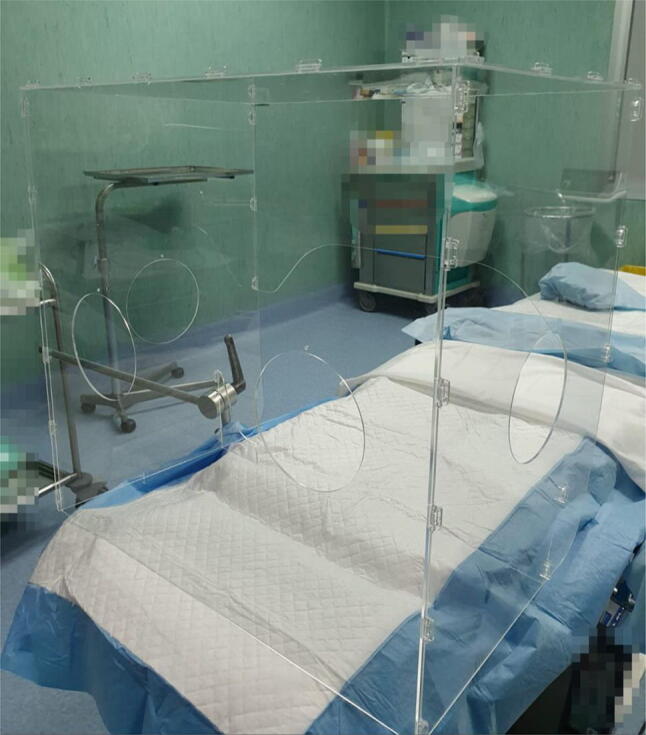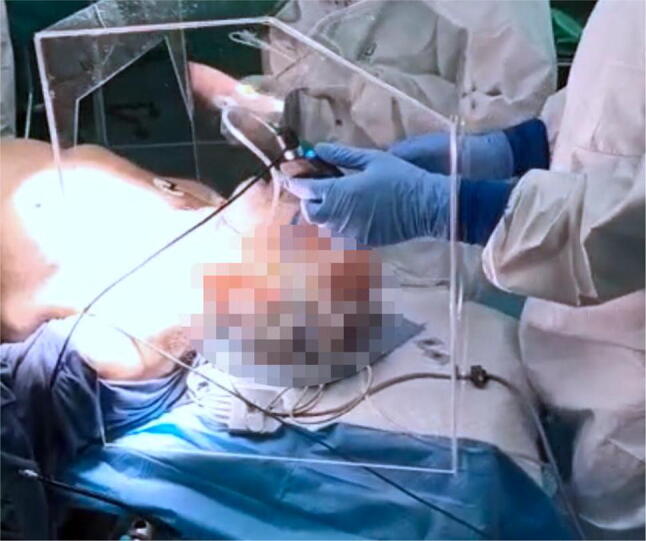Abstract
The COVID-19 pandemic is highly challenging for the operating room staff and healthcare workers in emergency departments. SARS-CoV-2 is a positive-sense single-stranded RNA beta-coronavirus that primarily targets the human respiratory system, with fever, cough, myalgia, and pneumonia as the most common manifestations. However, since SARS-CoV-2 RNA was detected in stool specimens much more attention has been paid to gastrointestinal symptoms such as loss of appetite, nausea, and diarrhea. Furthermore, the expression of ACE-2 receptors in absorptive enterocytes from ileum and colon suggests that these organs should also be considered as a potential high risk for SARS-CoV-2 infection. During aerosol-generating medical procedures (AGMP; e.g. intubating and extubating patients or any surgical procedures), the production of both airborne particles and droplets may increase the risk of infection. In this situation, the surgical staff is strongly recommended to wear personal protective equipment (PPE). A transparent plastic cube, the so-called “Aerosol Box” (AB), has been recently designed to lend further protection against droplets and aerosol exposure during the AGMP.
Keywords: COVID-19 pandemic, Personal protective equipment, Aerosol Box, Aerosol-generating medical procedures, Operating room
Introduction
The COVID-19 pandemic is highly challenging for the operating room staff and healthcare workers in the emergency departments [1, 2]. Secondary transmission occurs primarily via inhalation of droplets or airborne particle transmission and is common in the hospital setting [3].
During aerosol-generating medical procedures (AGMP), the production of both airborne particles and droplets may increase the risk of infection.
The World Health Organization (WHO) and the Centers for Disease Control and Prevention (CDC) defined a list of AGMP, during which the use of personal protective equipment (PPE) should be recommended for all involved theater staff [4, 5].
PPE consists of head covering, eye protection, N95 mask, gloves, and long-sleeved gowns [6].
The main determinant of the risk of contagion is the total viral load in the secretions to whom the healthcare workers are exposed. For this reason, it is strongly recommended to limit as much as possible the period of close-proximity to the patients.
With this regard, the “Aerosol Box” (AB) has been claimed as a valuable protective resource during open suctioning of airways and endotracheal intubation or extubation [7].
This system, originally designed by a Taiwanese doctor on a simple cuboid with two access ports for arms [7], appears as a low cost, space-efficient and easy to set up a solution to restrict the area of contact against expelled aerosol particles [7, 8]. AB consists of a disposable polycarbonate sheet box, which can be re-used after careful decontamination with an appropriate cleansing agent.
In this study, we focus on the role of PPE and AB in preventing transmission among operating room staff.
Patients and outcomes
We report a retrospective case series of six COVID-19 positive male patients undergoing emergent surgical treatment for gastrointestinal complications. Clinical, operative, and postoperative details are described in Table 1.
Table 1.
Patients’ characteristics
| Patient | Age (Sex) | Diagnosis | Surgical Procedure | Post-operative course |
|---|---|---|---|---|
| 1 | 59 (M) | Segmental small bowel ischemia | Emergent Laparotomy with small bowel resection and side-to-side anastomosis | MOF On the 5th postoperative day |
| 2 | 63 (M) | Segmental small bowel ischemia | Emergent Laparotomy with small bowel resection and side-to-side anastomosis | Uneventful; Discharged after 10 days |
| 3 | 77 (M) | Segmental small bowel ischemia | Emergent Laparotomy with small bowel resection and ileostomy | Uneventful; Discharged after 14 days |
| 4 | 71 (M) | Perforated sigmoid diverticulitis | Emergent Laparotomy and Hartmann’s procedure | MOF On the 3rd postoperative day |
| 5 | 56 (M) | Bowel obstruction | Emergent Laparotomy Hartmann’s procedure | Uneventful; Discharged after 10 days |
| 6 | 68 (M) | Acute calculous cholecystitis | Laparoscopic cholecystectomy | Uneventful; Discharged after 7 days |
MOF multiorgan failure
Prior to surgery, the diagnosis of COVID-19 was confirmed by reverse transcription–polymerase chain reaction (RT-PCR) testing and chest computed tomography.
All intubations were undertaken under video-laryngoscope guidance through a 60 cm × 60 cm × 40 cm polycarbonate sheet AB (Figs. 1, 2) with 4 circular (2 lateral and 2 posterior) ports.
Fig. 1.

The Aerosol Box (60 × 60 × 40 cm)
Fig. 2.

The use of the Aerosol Box during endotracheal intubation under video-laryngoscope guidance
All laparoscopic procedures were performed in a negative pressure room by minimizing the use of electrocautery, reducing the trocars-size, and using the appropriate devices to filter released CO2 for aerosolized particles [9]. Post-operative admission to the intensive care unit (ICU) for mechanical ventilation was planned for all patients.
Discussion
The novel coronavirus disease affects predominantly the upper airways, but gastrointestinal symptoms (GIs) occur in up to one-third of patients. A recent meta-analysis including 60 studies and 4243 patients from six countries reported a prevalence of GIs of 17.6% [10]. Interestingly, almost half of the patients’ stool sample tested positive for novel coronavirus RNA.
The high rate of small bowel involvement in our series is probably due to the expression of angiotensin-converting enzyme (ACE)-2 receptors on the brush border of enterocytes [11]. Furthermore, ischemic complications are related to both the hypercoagulability state and the endothelial injury caused by COVID-19.
The mortality rate was consistent with that reported by Kaafarani et al. [12] and maybe credited to the delayed surgical treatment resulting from the patient’s fear and health system overload [13].
Intubation is a high-risk aerosolizing procedure [4, 5]. A recent report emphasizes the looming threat of COVID-19 infection to complicate the course of patients undergoing surgery [14]. At the same time, the risk of surgical team members' cross-infecting patients and other staff is high [6].
Respiratory protection is mandatory during the COVID-19 pandemic even if the evidence on PPE effectiveness is still low. In fact, two randomized controlled trials showed no differences in terms of infection rate among surgical masks and N95 [15, 16].
A recently developed global guidance for surgical care advises on the use of local protocols for PPE in the operating theatre, including scrubbing, donning, and doffing techniques [6].
It still remains uncertain whether COVID-19 can be found in abdominal fluids or aerosols created during gas insufflation. Decision making and agreed procedural steps for gaining access into the abdominal cavity strictly depend on such understanding.
The risk of transmission of COVID-19 during laparoscopy remains theoretical but cannot be ruled out, given oral, nasal, and ocular exposure. For this reason, it is good practice to check all instruments and the proper functioning of the suction system before starting the procedure; to use balloon trocars and create suitable holes for leak-free trocars insertion; to avoid leaks of smoke obstructing the surgical field, which should be removed via the vacuum suction device; and to fully deflate pneumoperitoneum before making a service incision, and at the end of the procedure prior to trocar extraction [9].
Exposure to aerosol droplets represents a further potential source of infection when inserting or removing an endotracheal tube in the theatre.
Nevertheless, the Aerosol Box has raised some criticism concerning its innate features, namely that one box size does not fit all and the inability to warrant accurate manipulation of a gum elastic bougie or any other device used in securing an airway [17]. High-quality evidence supporting any aspect of PPE is lacking [18]. Innovation should be encouraged, but caution should be applied.
Conclusions
Considering the high risk of disease transmission during AGMP, we support the use of both PPE and AB to protect surgical staff during the current COVID-19 outbreak.
Author contributions
FB, PI, UG & GG contributed equally to this work: Substantial contributions to the conception and design of the work; acquisition, analysis, and interpretation of data for the work. Drafting the work and revising it critically for important intellectual content. Final approval of the version to be published. Agreement to be accountable for all aspects of the work in ensuring that questions related to the accuracy and integrity of any part of the work are appropriately investigated and resolved.
Compliance with ethical standards
Conflict of interest
All authors declare no personal conflict of interest.
Ethical approval
This study was approved by our local ethics committee and written informed consent was obtained from all patients. All procedures performed in studies involving human participants were in accordance with the ethical standards of the institutional and/or national research committee and with the 1964 Helsinki Declaration and its later amendments or comparable ethical standards. This article does not contain any studies with animals performed by any of the authors.
Informed consent
Informed consent was obtained from all individual participants included in the study.
Footnotes
Publisher's Note
Springer Nature remains neutral with regard to jurisdictional claims in published maps and institutional affiliations.
References
- 1.Pertile D, Gallo G, Barra F. The impact of COVID-19 pandemic on surgical residency programmes in Italy: a nationwide survey on behalf of the Italian polyspecialistic society of young surgeons (SPIGC) Updates Surg. 2020 doi: 10.1007/s13304-020-00811-9. [DOI] [PMC free article] [PubMed] [Google Scholar]
- 2.Patriti A, Eugeni E, Guerra F. What happened to surgical emergencies in the era of COVID-19 outbreak? Considerations of surgeons working in an Italian COVID-19 red zone. Updates Surg. 2020 doi: 10.1007/s13304-020-00779-6. [DOI] [PMC free article] [PubMed] [Google Scholar]
- 3.Wu Z, McGoogan JM. Characteristics of and important lessons from the coronavirus disease 2019 (COVID-19) outbreak in China: summary of a report of 72 314 cases from the Chinese center for disease control and prevention. JAMA. 2020 doi: 10.1001/jama.2020.2648. [DOI] [PubMed] [Google Scholar]
- 4.https://www.who.int/publications-detail/clinical-management-of-severe-acute-respiratory-infection-when-novel-coronavirus-(ncov)-infection-is-suspected. Accessed May 2 2020.
- 5.https://www.cdc.gov/coronavirus/2019-ncov/hcp/clinical-guidance-management-patients.html. Accessed 2 May 2020
- 6.COVIDSurg Collaborative Global guidance for surgical care during the COVID-19 pandemic. Br J Surg. 2020 doi: 10.1002/bjs.11646. [DOI] [PMC free article] [PubMed] [Google Scholar]
- 7.Canelli R, Connor CW, Gonzalez M, Nozari A, Ortega R. Barrier enclosure during endotracheal intubation. N Engl J Med. 2020;382(20):1957–1958. doi: 10.1056/NEJMc2007589. [DOI] [PMC free article] [PubMed] [Google Scholar]
- 8.Bianco F, Ranieri AJ, Paterniti G, Pata F, Gallo G (2020) Acute intestinal ischaemia in a patient with COVID-19. Tech Coloproctol [In press] [DOI] [PMC free article] [PubMed]
- 9.Gallo G, La Torre M, Pietroletti R, et al. Italian society of colorectal surgery recommendations for good clinical practice in colorectal surgery during the novel coronavirus pandemic. Tech Coloproctol. 2020;24(6):501–505. doi: 10.1007/s10151-020-02209-6. [DOI] [PMC free article] [PubMed] [Google Scholar]
- 10.Cheung KS, Hung IF, Chan PP, et al. Gastrointestinal manifestations of SARS-CoV-2 infection and virus load in fecal samples from the hong kong cohort and systematic review and meta-analysis. Gastroenterology. 2020 doi: 10.1053/j.gastro.2020.03.065. [DOI] [PMC free article] [PubMed] [Google Scholar]
- 11.Perlot T, Penninger JM. ACE2—from the renin-angiotensin system to gut microbiota and malnutrition. Microbes Infect. 2013;15(13):866–873. doi: 10.1016/j.micinf.2013.08.003. [DOI] [PMC free article] [PubMed] [Google Scholar]
- 12.Kaafarani HMA, El Moheb M, Hwabejire JO, et al. Gastrointestinal complications in critically ill patients with COVID-19. Ann Surg. 2020 doi: 10.1097/SLA.0000000000004004. [DOI] [PMC free article] [PubMed] [Google Scholar]
- 13.La Torre M, Pata F, Gallo G. Delayed benign surgery during the COVID-19 pandemic: the other side of the coin. Br J Surg. 2020 doi: 10.1002/bjs.11712. [DOI] [PMC free article] [PubMed] [Google Scholar]
- 14.Aminian A, Safari S, Razeghian-Jahromi A, Ghorbani M, Delaney CP. COVID-19 outbreak and surgical practice: unexpected fatality in perioperative period. Ann Surg. 2020 doi: 10.1097/SLA.0000000000003925. [DOI] [PMC free article] [PubMed] [Google Scholar]
- 15.Radonovich LJ, Jr, Simberkoff MS, Bessesen MT, et al. N95 respirators vs medical masks for preventing influenza among health care personnel: a randomized clinical trial. JAMA. 2019;322(9):824–833. doi: 10.1001/jama.2019.11645. [DOI] [PMC free article] [PubMed] [Google Scholar]
- 16.Loeb M, Dafoe N, Mahony J, et al. Surgical mask vs N95 respirator for preventing influenza among health care workers: a randomized trial. JAMA. 2009;302(17):1865–1871. doi: 10.1001/jama.2009.1466. [DOI] [PubMed] [Google Scholar]
- 17.Kearsley R (2020) Intubation boxes for managing the airway in patients with COVID-19 Anaesthesia; 10.1111/anae.15081 [DOI] [PMC free article] [PubMed]
- 18.Cook TM. Personal protective equipment during the coronavirus disease (COVID) 2019 pandemic—a narrative review. Anaesthesia. 2020 doi: 10.1111/anae.15071. [DOI] [PubMed] [Google Scholar]


